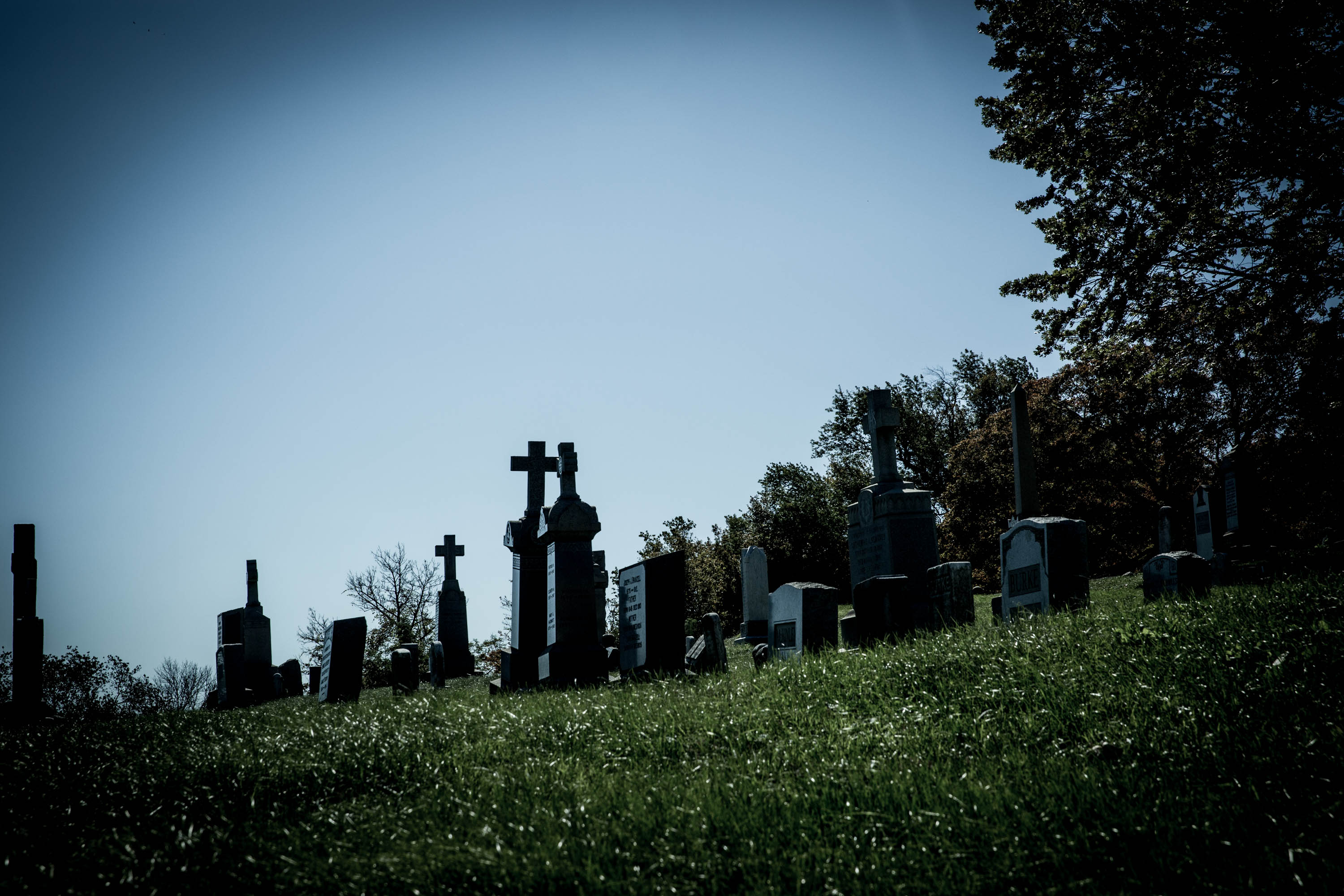Haunted historians, would-be paranormal investigators and Halloween enthusiasts at the George Washington University are in luck: Washington, D.C., has more than its share of local ghost stories. For the Halloween season, GW Today rounded up the spirited history of some of the eeriest places in the nation’s capitol. Scroll down…if you dare.
The White House
The Octagon House & Museum
Decatur House
Lafayette Square
The Hay-Adams Hotel
Oak Hill Cemetery
The Exorcist Steps
The Old Stone House
Holy Rood Cemetery
U.S. Capitol Building
The White House
1600 Pennsylvania Ave.

Reports of ghosts at the White House are legion. “The damned place is haunted sure as shootin’,” a creeped-out President Harry Truman wrote to his wife in 1946 after a night of mysterious knocking and footsteps."You and [the Trumans' daughter] Margie had better come back and protect me before some of these ghosts carry me off."
Mary Todd Lincoln, a devout spiritualist who turned to the paranormal as a balm during a life crowded with personal and national tragedy, is said to have heard Andrew Jackson stomping and cursing in the Rose Room. Thomas Jefferson plays the violin in the Yellow Oval Room. William Henry Harrison, the first president to die in the White House, lurks in the attic. Even Hillary Rodham Clinton sometimes got the shivers there: “There is something about the house at night that you just feel like you are summoning up the spirits of all the people who have lived there and worked there and walked through the halls there,” she told Rosie O’Donnell in 1996. “It's neat. It can be a little creepy.”
The White House’s best-documented phantom is Abraham Lincoln. First Lady Grace Coolidge reported seeing him gazing out the window of the Oval Office. Queen Wilhelmina of the Netherlands is said to have fainted upon sighting him on a visit in 1942. But Winston Churchill may have had the best—or at least the most vivid—Lincoln encounter, according to Mark Nesbitt in “Civil War Ghost Trails: Stories from America’s Most Haunted Battlefields.”
"Winston Churchill, during his visits in the 1940s, never liked sleeping in the Lincoln bedroom… During one visit, after taking a hot bath (accompanied by a glass of scotch and omnipresent cigar) he emerged from the tub and strolled naked into an adjoining room where he ran right into Lincoln, who was leaning on the mantle above the fireplace. They looked each other in the face. Churchill was embarrassed. Lincoln simply vanished."
Whether President Donald Trump's recent renovations will affect the ghosts is unknown.
The Octagon House and Museum
1799 New York Ave. NW

“The Octagon House has long had the reputation of being haunted,” author and socialite Mary Clemmer Ames wrote in 1873. This looming mansion, where James and Dolley Madison lived after the White House burned in the War of 1812, still retains its title as “the most haunted building in D.C.” Reported paranormal manifestations include poundings on the wall, floating spectral lights and the inexplicable jangling of servants’ bells: “It is an authenticated fact, that every night, at the same hour, all the bells would ring at once,” Ames wrote.
Unfortunately for would-be ghost hunters, historians have debunked the enduring legend that two members of the original builder’s family died in the house. But, as believers will counter, that’s no guarantee they haven’t returned to walk its halls. Now owned by the Architects Foundation, the house is a museum and exhibit space open to visitors by appointment only.
Decatur House
748 Jackson Pl. NW

Commodore Stephen Decatur was a war hero and even a speculative presidential hopeful when he built this stately town house, the first private residence in the White House neighborhood. But only 14 months after moving in, he was challenged to a duel and killed. Two hundred years later, the spirit of Stephen Decatur is said to gaze out of a bricked-up window on the second floor. Some report that empty rooms echo with the sound of a woman sobbing—a woman presumed to be the commodore’s grieving widow.
Lafayette Square
H Street and Jackson Place, NW.

Decatur's death in 1820 wasn't the last homicide to be committed just yards from the White House. In 1859 Lafayette Square saw one of D.C.’s most notorious slayings—committed in broad daylight by a sitting congressman.
U.S. Rep. Daniel Sickles (D-N.Y.) was notorious in his time for his extramarital dalliances. But he became enraged upon the discovery that his much-younger wife was having an affair of her own with Philip Barton Key, district attorney of the District of Columbia and the son of “Star-Spangled Banner” composer Francis Scott Key. According to a contemporary account, when Key passed the Sickles’ Lafayette Square house waving his handkerchief, Sickles—who believed his rival was making another adulterous overture—charged out and shot him twice.
Sickles’ was the first case in the United States to successfully use “temporary aberration of mind” as a defense. He would go on to a disastrous command at Gettysburg, where he went against orders, destroyed his battalion and lost a leg. (Cementing his reputation as one of the strangest figures in Civil War-era Washington, Sickles had his leg shipped to the National Museum of Health and Medicine in a small box with a card reading “With the compliments of Major General D.E.S.” The leg is still part of the museum’s collection.)
Key’s ghost, meanwhile, is said to appear in Lafayette Square between 15th and 16th streets, where he was shot. According to Dennis William Hauck’s “Haunted Places: The National Directory," the apparition revealed itself in 1865 to Secretary of State William Seward to warn him of an upcoming assassination attempt.
Hay-Adams Hotel
One Lafayette Sq. NW

The chandelier in the lobby of the Hay-Adams Hotel is rumored to chime and swing in the wake of the hotel's ghost. (Courtesy Hay-Adams Hotel)

In its 100-year history, the elegant Hay-Adams Hotel has hosted celebrities from Amelia Earhart to Angelina Jolie. The Obama family stayed there prior to the 2009 inauguration. The hotel’s rumored apparition, too, was a luminary: Marion “Clover” Hooper Adams, an accomplished photographer who, at the age of 42, committed suicide using the darkroom chemical potassium cyanide. The chandelier at the entryway to the Hay-Adams Room is said to sway at her passing, and her scent supposedly lingers in the halls. A side note: Adams' grave in Rock Creek Cemetery is marked by one of D.C.'s loveliest and most haunting memorial sculptures.
Oak Hill Cemetery
3001 R St. NW

Like many cemeteries, Oak Hill's ambience is more peaceful than creepy. It's the final resting place of many Washington notables, including Washington Post publisher Philip Graham and William Wilson Corcoran, founder of the Corcoran Gallery of Art. It also houses the less well known but perhaps equally influential Jacob Fussell, who opened the United States’ first wholesale ice cream house in 1851.
Oak Hill Cemetery also is the setting of George Saunders' Man Booker Prize-winning "Lincoln in the Bardo." The novel centers on the ghost of Abraham Lincoln's 11-year-old son, Willie, who was briefly interred here before being moved to Springfield, Ill., after his father's assassination in 1865.
The Exorcist Steps
3600 Prospect St. NW

A major character meets his end on this precipitous stairway in the iconic 1973 film “The Exorcist.” Accordingly, it’s a pilgrimage site for horror fans—and athletes, many of whom get their cardio fix sprinting up and down a rise equivalent to the height of a five-story building. Hundreds of Georgetown University students, faculty and staff took roles as extras during filming, and according to Elizabeth Tucker’s “Haunted Halls: Ghostlore of American College Campuses,” students even charged spectators five dollars to watch a stuntman fall down 75 steps (padded with half an inch of rubber).
Old Stone House
3051 M St NW

The Old Stone House is the oldest structure on its original foundation in Washington, D.C., already 59 years old when the British invaded the city in 1814. Now renovated, it retains much of its original flooring, paneling and walls. The house’s age practically guarantees haunting rumors, and it doesn’t disappoint: According to "Haunted Places," there are at least 11 reported apparitions, including “a stout woman in an antebellum gown,” “a small boy named Joey” and “a German carpenter.”
The Old Stone House also is rumored to contain of one of D.C.’s few malevolent spirits. Known as “George,” it supposedly travels the third floor in an ominous cold spot and is said to have choked and pushed visitors. In 2018, a WTOP journalist caught an unsettling recording in the Old Stone House that sounds like a paranormal whisper. Of the house, with its "ominous" and unwelcoming vibes, the journalist wrote, "I have no desire to visit there again."
Holy Rood Cemetery
2126 Wisconsin Ave. NW

The 176-year-old cemetery now known as Holy Rood had fallen into disrepair in the mid-00s, but was revitalized thanks to community efforts during the first year of the COVID-19 pandemic—an invaluable preservation effort, since Holy Rood is one of the best-documented burial sites for Washington's enslaved people and free Catholic African-Americans.
U.S. Capitol Building
East Capitol St. NE & First St. SE

Some of the Capitol’s specters aren’t even human. A “demon cat” supposedly prowls the 200-year-old building in times of national crisis, growing to enormous size and then vanishing.



